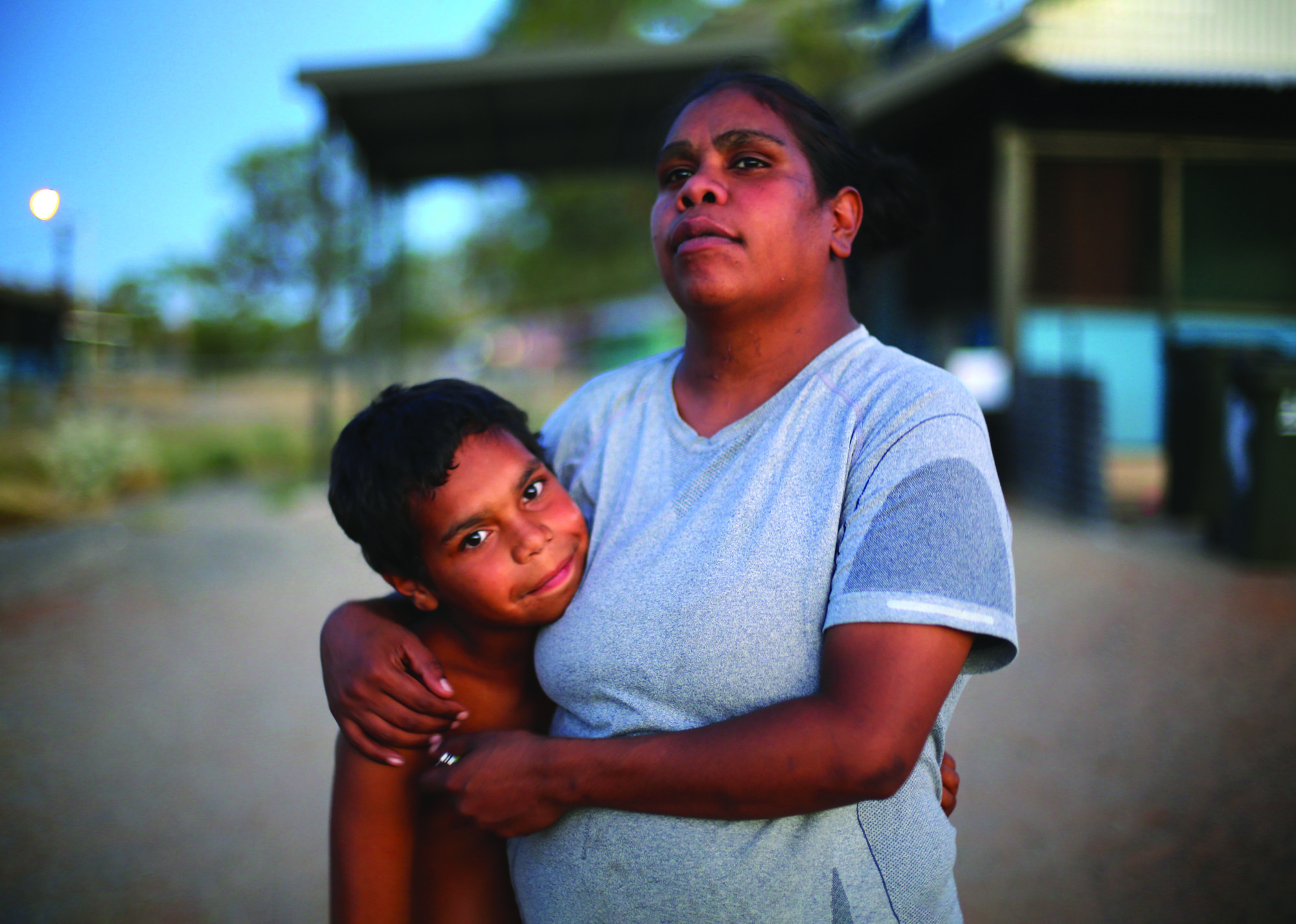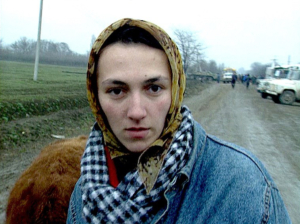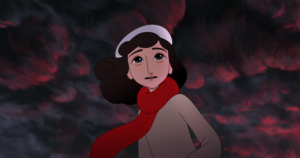In My Blood It Runs (Maya Newell, 2019) is a beautifully constructed documentary that tells the story of ten-year-old Arrernte/Garrwa boy Dujuan Hoosan. Filmed over a three-year period, it taps into the enduring strength and dignity of Aboriginal people and cultures, while also exposing the stress, struggle and conflict that arise from having to fit into the social structures, education and pathways that have been shaped by Europeans. Through getting to know Dujuan and his extended family, the viewer is immersed in his world of contrasts. In one frame, his cheeky smile and laughter fills up the screen; in another, we observe his reverence for his time-honoured culture and his awareness of his place within it. Elsewhere, however, his joy melts away, replaced by the dejection he feels in the classroom setting. Through its many contrasting elements, In My Blood It Runs intimately exposes the uneasy truth that, for many Aboriginal children like Dujuan, there is no easy answer to the complex and conflicting conditions governing their lives – nor to the looming prospect of juvenile incarceration (and worse).
Despite this, In My Blood It Runs is not just a film about the pain and dispossession that many First Nations people feel. It is also a film that presents and celebrates its subjects’ deep spirituality, resilience, and connection to country and one another. It takes to task the anachronistic idea that Aboriginal people should be expected to conform to the structures, policies and way of life that have been forced on them by the conquering culture since the landing of the First Fleet. It challenges the Australian Government’s out-of-touch, bureaucratic response to Indigenous children’s education, and shows that high rates of juvenile incarceration should not be treated as a foregone conclusion. Finally, it invites the audience to listen closely to Dujuan’s testimony, which shows him to be strong, resilient, connected and purposeful when he is allowed to live as an Aboriginal child, surrounded by the types of learning and doing that interest him the most. Ultimately, it is a moving portrait of a charismatic child who has a clear sense of his path, and who wishes to be free to follow it.
• In a small group, choose one of the following research topics: Aboriginal spirituality; Aboriginal tribal cultures; the 2016 Royal Commission into the Protection and Detention of Children in the Northern Territory; and the history of Aboriginal educational policy in the Northern Territory. Gather facts and combine them on one big poster or in a Keynote presentation, and present your findings to the rest of the class.
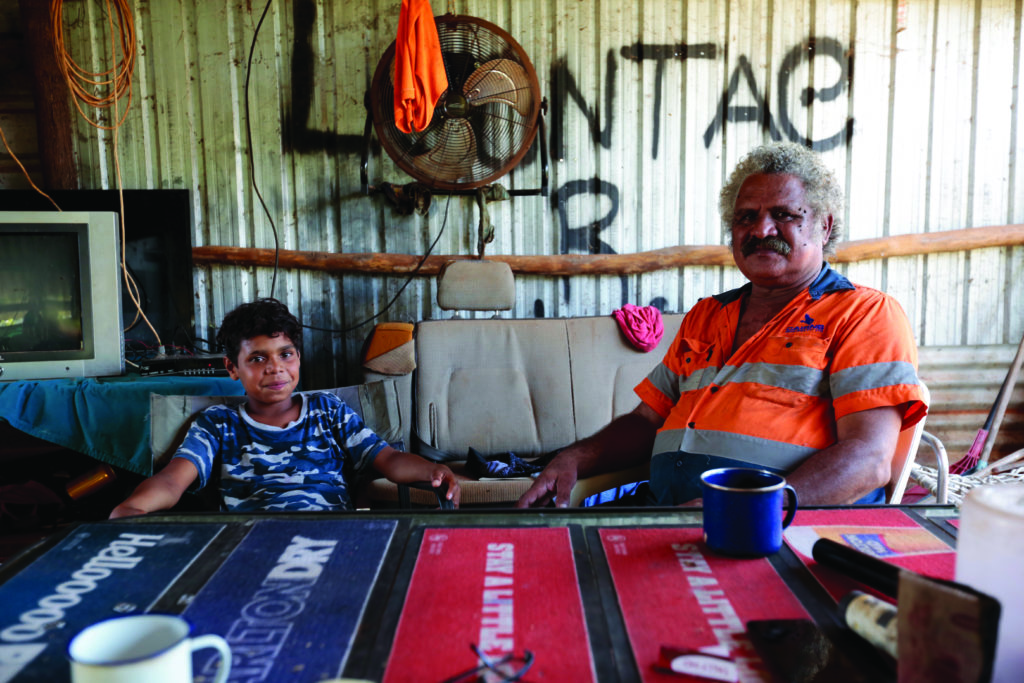
Learning language and culture
In My Blood It Runs explores and reveals the importance of traditional language, culture and spirituality in Dujuan’s life and in the lives of Aboriginal people more broadly. Trapped as he is between Aboriginal and white Australian cultures, Dujuan’s life in Alice Springs is both simple and complicated. He lives with his mother, Megan, and grandmother, Carol, who both worry about his escalating truancy and disengagement from mainstream education. Dujuan’s relationship with his mother, whom he refers to by first name, is portrayed as being warm and loving; they are seen talking and laughing together in the opening of the film.
However, it is Nana Carol who is shown to be Dujuan’s main source of comfort and guidance. She is the one who fusses over him the most and takes charge of his spiritual development. Central to this is their ancestral homeland, Sandy Bore, where she takes Dujuan to be ‘realigned’ when he acts out too much. It is at Sandy Bore that he and the other children connect with their elders and learn the traditional stories. It is also a place where they must only speak in their tribal language, Arrernte. The scenes at Sandy Bore highlight the richness of Aboriginal family structures and traditional cultures; they also show that Dujuan already occupies an important place within his own world. At home, it is Nana Carol who pushes him to speak Arrernte with her and who talks to him about his role as a tribal healer, or ngangkere. She encourages Dujuan to use his healing powers and asks him to practise them on her. Nana Carol’s love and care for Dujuan, together with her guiding presence as he develops and uses his skills, exerts a calming and steadying influence on him, one that Newell portrays as being crucial to the direction that his life will take.
• In pairs, think and talk about someone in your family who has guided and protected you, provided you with encouragement or helped you to deal with difficult situations in your life.
• Write a profile of this person on a piece of coloured paper, describing their qualities and the many ways that they have helped you and made you feel safe and loved.
• Find three symbols that represent this person and add them to the profile. They might be animals, objects or something abstract, like music. Explain why these symbols represent your person.

Contrasting approaches to education
One of the strongest messages of In My Blood It Runs is the failure of the mainstream education system to properly address the needs of Indigenous Australian children. Dujuan is portrayed as becoming increasingly disengaged from learning when in attendance at his local school. From his slumped body language in the classroom to the crushing sense of personal failure he expresses over his low grades, we see the bright spark that elsewhere shines within him become dimmer and duller when at school.
The causes of this situation soon become painfully obvious. In one scene, Dujuan and the other Aboriginal children in the classroom listen to their teacher read from Eve Pownall’s The Australia Book, which was published in 1952. The extract recounts a whitewashed version of Australian history, which pushes the idea that the British Empire had the right to take Australia for its own based on the concept of terra nullius. Listening to this reading brings obvious discomfort to Dujuan, who elsewhere states, ‘Before […] everything around the world wasn’t made, it was just Aboriginals on Australia.’ In another of the classroom scenes, a teacher talks about one of the Dreamtime stories, laughingly telling the students that she finds it confusing and that ‘we’ve just got to believe it’. For one of Dujuan’s classmates, the temptation to yell out, ‘Spirit is real, ay!’ is too much.
The scenes at Sandy Bore highlight the richness of Aboriginal family structures and traditional cultures; they also show that Dujuan already occupies an important place within his own world.
The confusion, indignation and discomfort that Aboriginal students such as Dujuan feel in such a culturally insensitive setting could not be more apparent, pushing him to begin acting out by running away from school. However, in his own culture and family group – and especially when he returns to his traditional homeland – he is self-possessed and self-assured. He can speak three languages, including English, and is recognised as a healer by his people. When surrounded by his tribal elders, siblings and cousins, Dujuan is attentive to the lessons that they are teaching him and seems to know his purpose and place. The only other time that he appears fully engaged in learning is when he has Arrernte lessons at school, which have been cut down from an hour to half-an-hour in the curriculum. For Dujuan, mainstream schooling is an insult to everything he knows to be true about himself and his people. To listen to his explanations of his role as a healer throughout the film is to capture a glimpse into the deep connection that he already has to his people and their shared history and culture. ‘I was born a little Aboriginal kid. That means that I had a memory – a memory about Aboriginals. I just felt something: a memory … history. In my blood it runs.’
• With a partner, research the term ‘terra nullius’ and the reasons why the British used this term to claim Australia as a new territory.
• Ask yourself the question: Was this an accurate term to use in describing Australia when the British claimed it for their own? Explain why or why not.
• Create a Keynote presentation explaining your findings and putting forward your argument. Include supporting evidence and provide a list of references on your last slide.
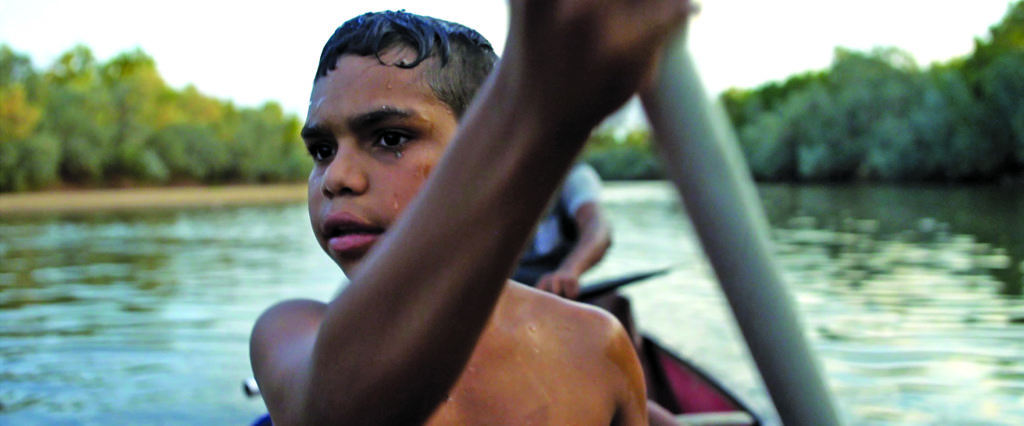
Disadvantage and self-determination
Along with his dwindling interest in school and his escalating truancy, Newell portrays Dujuan as struggling to find a place within a society that does not really value what he has to share. Standing on a hill somewhere in Hidden Valley, looking over the city of Alice Springs, he asks his friends, ‘How come this mob [has] clean houses and not us? […] I wish I had one of those houses.’ Dujuan is keenly aware that he is disadvantaged, and the footage of his house and local area further illustrates the fact that, while he may have the love of his family and friends, his living conditions are basic and often without important utilities such as electricity. The poverty that surrounds him and fellow members of the Hidden Valley community on the outskirts of Alice Springs reflects the fringe-dweller status that Aboriginal people in this country are still so often relegated to. The frustration that Dujuan feels over this only serves to fuel his escalating school truancy and increasingly bad behaviour. Individually, these factors are concerning enough, but in combination they push Dujuan to take his first reckless steps down the well-worn path leading to youth incarceration.
Many references, most of them direct, are made in the film to the threat of Aboriginal juvenile detention, which is openly invoked by Dujuan’s family members. Increasingly concerned, Nana Carol gets his Aunty Alexis to talk to him about her experiences in jail after he has run away from school again. When she does, she gives Dujuan a chilling warning: ‘Juvenile is not a good place to be, ’cause you’re only going to end up in two places: a jail cell or a coffin […] Go to school every day.’ The notorious Don Dale Youth Detention Centre in Berrimah – the same facility that was embroiled in a royal commission after the ABC’s Four Corners broke the story of the terrible abuse suffered by many of its juvenile Aboriginal inmates in 2016[1]‘Australia’s Shame’, Four Corners, available at
<https://www.abc.net.au/4corners/australias-shame-promo/7649462>, accessed 16 November 2020. – is the jail that Alexis refers to. According to statistics, three in five young people in detention in Australia in 2018 were Indigenous, despite the fact that they only make up 5 per cent of the population.[2]See Lilly Brown, ‘In My Blood It Runs Challenges the “Inevitability” of Indigenous Youth Incarceration’, The Conversation, 2 July 2020, <https://theconversation.com/in-my-blood-it-runs-challenges-the-inevitability-of-indigenous-youth-incarceration-140624>, accessed 16 November 2020. In Don Dale in 2018 – and, indeed, in the Northern Territory as a whole – all youth detainees were Aboriginal.[3]Lorena Allam, ‘All Children in Detention in the Northern Territory Are Indigenous’, The Guardian,26 June 2018, <https://www.theguardian.com/australia-news/2018/jun/25/all-children-in-detention-in-the-northern-territory-are-indigenous>, accessed 16 November 2020.

While this paints a depressing picture, In My Blood It Runs offers a glimmer of hope. Dujuan’s situation comes to a head when he throws his teacher’s car keys onto the roof of the school and is expelled. Nana Carol’s power and agency is highlighted here when she consults the other elders and they collectively decide that he should be sent to live with his father. While the majority of Australian citizens take for granted the ability to make decisions for their families and communities, it is something that Aboriginal people have long had to fight for. This is a topic that was openly addressed in discussions held post the 2016 royal commission; as then-minister Dale Wakefield told a territory government committee in 2018,
We need to make sure […] that local communities can make decisions around the ways they want to respond to young people who are not meeting community expectations in terms of their behaviour.[4]Dale Wakefield, quoted in Allam, ibid.
In My Blood It Runs affirms this right.
• Think of a time that someone has helped you in your life like Nana Carol helps Dujuan in the film. Write them a letter thanking them for what they have done for you, and let them know how their actions helped you.
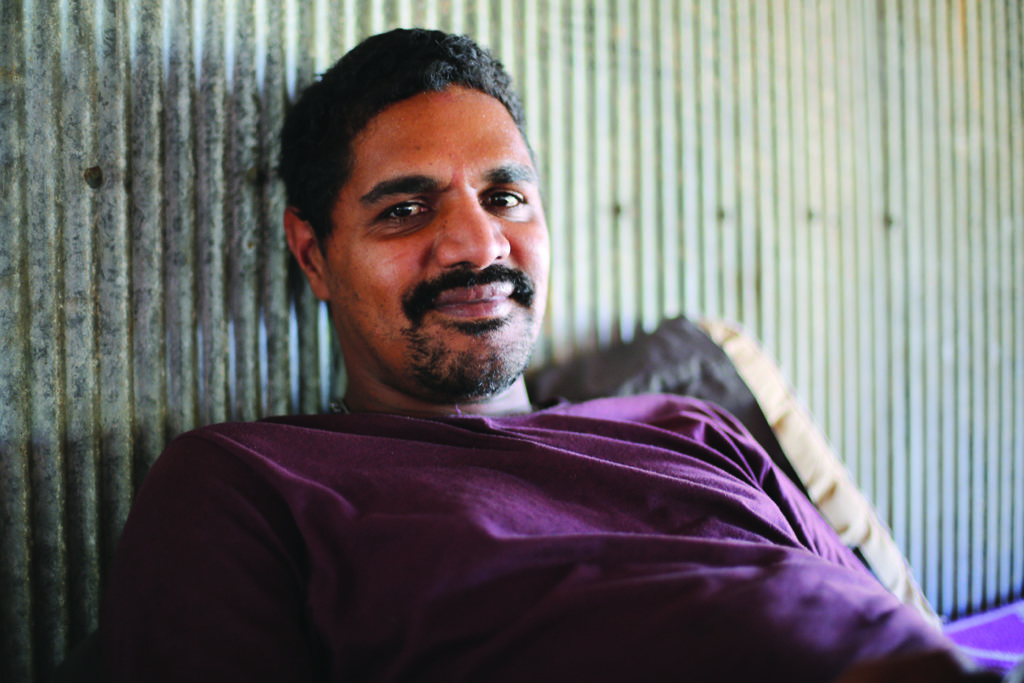
Hope and freedom
Up north with his father, Dujuan appears calmer and more grounded. In a swimming hole in the bush with his dad and extended family, he is just another happy kid, secure in the knowledge of his place in the world. This sequence brings a sense of symmetry to his story and a message of hope. Nana Carol’s visit to check on Dujuan’s progress highlights once again the powerful bond that he shares with her: ‘I’ll love her until I grow old.’ Although Dujuan misses her, he wants to stay with his father.
The final scenes of the documentary, showing him working with his father as they drive through the country conducting burn-offs, affirms that this has been the right decision for him. In one of these sequences, Dujuan reflects on his past and outlines his future:
History runs straight into all the Aboriginals. It travels all the way through, from my blood pipes all the way to the brain. And when I’m a man, I’m going to fight for rights for black people […] I’ll try and speak to the prime minister. I’m gonna say, ‘Stop killing Aboriginal people.’
He exceeded this goal in 2019 when he travelled to Geneva to deliver a speech to the United Nations Human Rights Council addressing youth incarceration and the educational system.[5]Rachel Clayton, ‘12yo Alice Springs Boy to Speak at United Nations in Push to Change Australia’s Age of Criminality’, ABC News, 11 September 2019, <https://www.abc.net.au/news/2019-09-11/12yo-aboriginal-boy-gives-speech-at-un-about-age-of-criminality/11492796>, accessed 16 November 2020.
• Think of an issue that you would like to present to the United Nations Human Rights Council. Watch Dujuan’s speech[6]See ‘The Speech 12 Year Old Aboriginal Child, Dujuan, Delivered at the UN Human Rights Council’, Human Rights Law Centre website, 11 September 2019, <https://www.hrlc.org.au/news/2019/9/11/the-speech-12-year-old-dujuan-delivered-at-the-un-human-rights-council>, accessed 16 November 2020. and then write your own speech arguing for human rights.
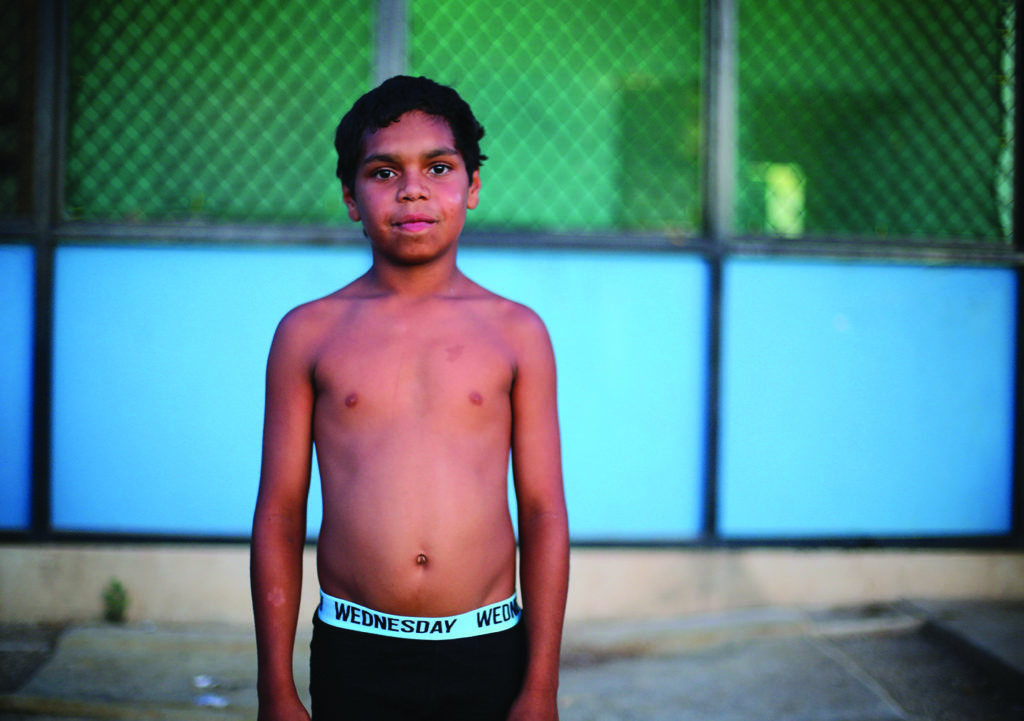
‘Just being me’
Newell’s powerful documentary immerses viewers in its intimate and moving story. As the focus of this film, Dujuan is charismatic; bright and cheeky, he lights up the screen with his smile and his presence, even as his troubles with school cast an ominous shadow. He represents the many Aboriginal children who struggle against the conformity and compliance demanded of them by the bureaucratic structures enforced by the Australian Government. From mainstream school to expectations of future pathways, he demonstrates that Aboriginal kids often do not feel understood or heard, and that this can lead to disaster. Nonetheless, Dujuan is one of the lucky ones: with the love and help of his mother and Nana Carol, he finds his place with his father and his extended family up north, where he can go to school and be engaged and also spend weekends in the bush. We see that what Dujuan has learned from his struggles has become a powerful catalyst for him, prompting him to become a voice on the issue of mistreatment of Aboriginal children in juvenile detention. But perhaps the most resonant message of the film is conveyed by Dujuan himself, as he travels through his homeland with his father, setting fire to the land just as their ancestors did for thousands of years: ‘What I want is a normal life of just being me. And what I mean by “me” is I want to be an Aborigine.’
Endnotes
| 1 | ‘Australia’s Shame’, Four Corners, available at <https://www.abc.net.au/4corners/australias-shame-promo/7649462>, accessed 16 November 2020. |
|---|---|
| 2 | See Lilly Brown, ‘In My Blood It Runs Challenges the “Inevitability” of Indigenous Youth Incarceration’, The Conversation, 2 July 2020, <https://theconversation.com/in-my-blood-it-runs-challenges-the-inevitability-of-indigenous-youth-incarceration-140624>, accessed 16 November 2020. |
| 3 | Lorena Allam, ‘All Children in Detention in the Northern Territory Are Indigenous’, The Guardian,26 June 2018, <https://www.theguardian.com/australia-news/2018/jun/25/all-children-in-detention-in-the-northern-territory-are-indigenous>, accessed 16 November 2020. |
| 4 | Dale Wakefield, quoted in Allam, ibid. |
| 5 | Rachel Clayton, ‘12yo Alice Springs Boy to Speak at United Nations in Push to Change Australia’s Age of Criminality’, ABC News, 11 September 2019, <https://www.abc.net.au/news/2019-09-11/12yo-aboriginal-boy-gives-speech-at-un-about-age-of-criminality/11492796>, accessed 16 November 2020. |
| 6 | See ‘The Speech 12 Year Old Aboriginal Child, Dujuan, Delivered at the UN Human Rights Council’, Human Rights Law Centre website, 11 September 2019, <https://www.hrlc.org.au/news/2019/9/11/the-speech-12-year-old-dujuan-delivered-at-the-un-human-rights-council>, accessed 16 November 2020. |
